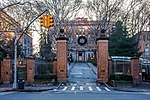Rockefeller War Demonstration Hospital
1910s in Manhattan1917 establishments in New York CityClosed medical facilities of the United States ArmyDefunct hospitals in ManhattanDemolished buildings and structures in Manhattan ... and 10 more
Hospitals disestablished in 1919Hospitals established in 1917Hospitals of the United States ArmyInstallations of the United States Army in New York (state)Military facilities in ManhattanMilitary history of New York CityRockefeller UniversityUpper East SideUse mdy dates from February 2021World War I sites in the United States

Rockefeller Demonstration Hospital, also known as Rockefeller base hospital and United States Army Auxiliary Hospital No. 1 was a World War One era field hospital designed, located and operated by Rockefeller Institute for Medical Research in Manhattan, New York City.
Excerpt from the Wikipedia article Rockefeller War Demonstration Hospital (License: CC BY-SA 3.0, Authors, Images).Rockefeller War Demonstration Hospital
York Avenue, New York Manhattan
Geographical coordinates (GPS) Address Phone number Website Nearby Places Show on map
Geographical coordinates (GPS)
| Latitude | Longitude |
|---|---|
| N 40.7625 ° | E -73.955555555556 ° |
Address
Rockefeller University
York Avenue 1230
10065 New York, Manhattan
New York, United States
Open on Google Maps






